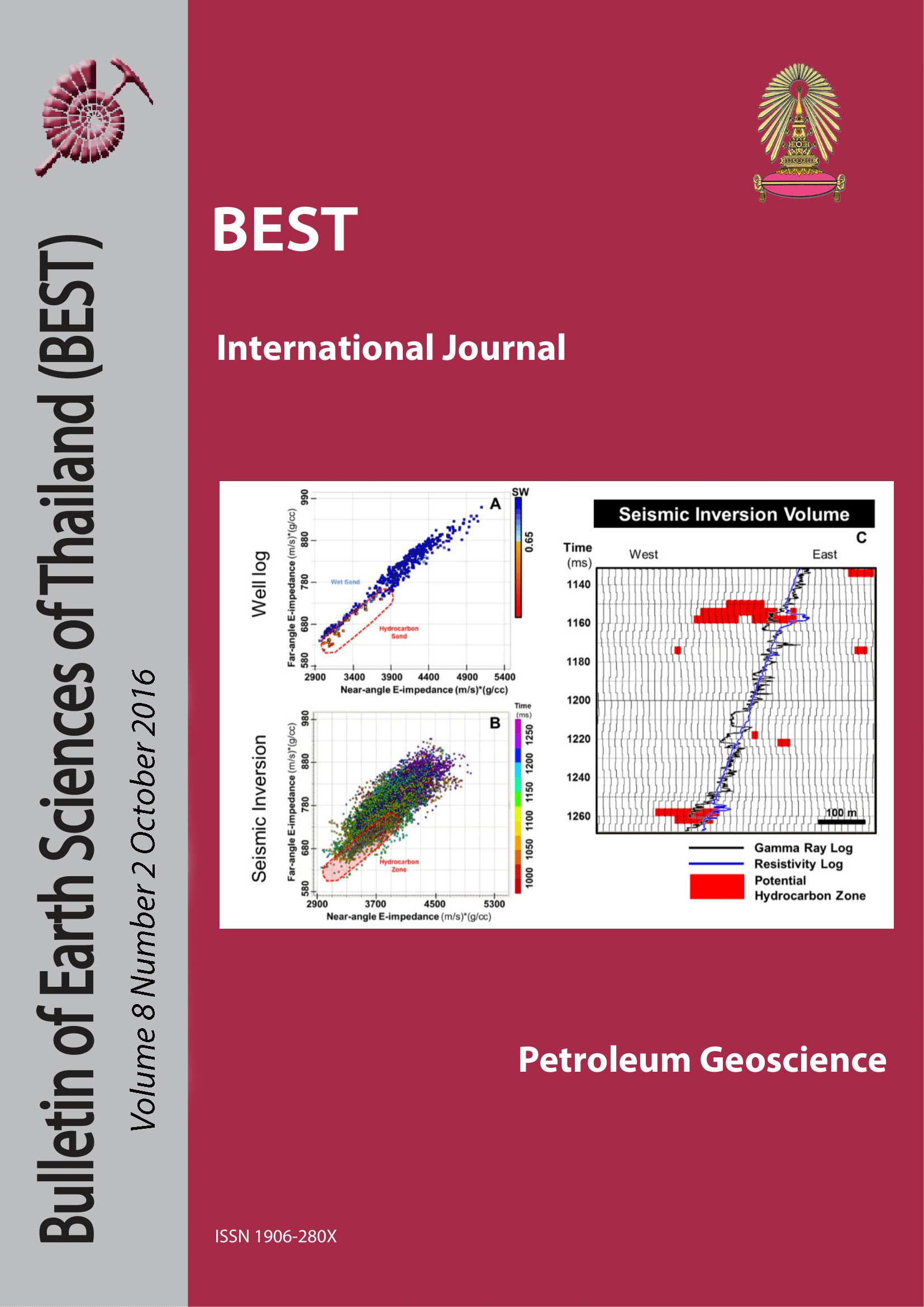ELASTIC IMPEDANCE INVERSION FOR RESERVOIR AND HYDROCARBON IDENTIFICATION, NORTHERN PATTANI BASIN, GULF OF THAILAND
Main Article Content
Abstract
The study area is located in the northern part of the Pattani Basin, Gulf of Thailand. The main reservoirs in this Basin are early to middle Miocene fluvial sandstone. The imaging of these reservoirs using seismic data is always challeng-ing due to the rapid lateral and vertical lithological variations of fluvial systems. Also, the normal faulting in this Basin causes the reservoir to be highly compartmentalized. Rock physics analysis was studied and elastic impedance inversion techniques were applied to improve the reservoir imaging and to predict potential hydrocarbon bearing zone. According to the rock physic analysis, far-angle elastic impedance can differentiate between clean sand and shale in main reservoir interval. P-impedance and near-angle elastic impedance cannot clearly separate sand and shale in the studied intervals. Hydrocarbon sand shows lower values in far-angle elastic impedance compared to the wet sand, whereas P-impedance of hydrocarbon sand and wet sand falls in the same ranges. The far-angle elastic impedance inversion volume was generated. The inversion results show a reasonable match with the blind test wells which conform to the rock physics analysis. The sand mapping reveals that far-angle elastic impedance can detect sand distribution and it can predict potential hydrocarbon zones in the main reservoir interval. The hydrocarbon zones can be further confirmed by using the seismic crossplots of near-angle and far-angle elastic impedance inversion. This study shows that elastic impedance inversion can be used to predict the reservoir distribution and identify potential hydrocarbon zone.
Article Details

This work is licensed under a Creative Commons Attribution-NonCommercial-NoDerivatives 4.0 International License.
Copyright © 2008 Department of Geology, Faculty of Science, Chulalongkorn University. Parts of an article can be photocopied or reproduced without prior written permission from the author(s), but due acknowledgments should be stated or cited accordingly.
References
Connolly, P., 1999. Elastic impedance: The Leading Edge, v. 18, p. 438-452.
Dangprasitthiporn, M., 2015, Lithology prediction using rock physics and acoustic impedance for reservoir distribution in northern of the Pattani Basin, Gulf of Thailand: M.Sc. thesis, Chulalongkorn University, 40 p.
Jardine, E., 1997, Dual Petroleum Systems Governing The Prolific Pattani Basin Offshore Thailand: Proceedings of the Petroleum Systems of SE Asia and Australasia Conference, May 1997, p. 351-363.
Kachi, T., Yamada, H., Yasuhara, K., et al., 2005, Fault-seal analysis applied to the Erawan gas-condensate field in the Gulf of Thailand: AAPG Memoir 85, p. 59 – 78.
Li, Y., Guo, Z., Liu, C., et al., 2015, A rock physics model for the characterization of organic-rich shale from elastic properties, Petroleum Science, v. 12, issue 2, p.264-272.
Marion, D., 1990, Acoustical, mechanical, and transport properties of sediments and granular materials, Ph.D. thesis, Stanford University, 136p.
Morley, C.K., and Racey, A., 2011, Tertiary stratigraphy, in M.F. Ridd, A.J. Barber, and M.J. Crow, eds., The geology of Thailand: Geological Society of London, p. 223-271.
Narapan, J., 2015, Different types of organic-rich geological markers in south Pailin Field, Pattani Basin, Gulf of Thailand: M.Sc. thesis, Chulalongkorn University, 51 p.
Rigo de Righi, L., Baranowski J., Chaikiturajai C., Nelson G., Wechsler D., and Mattingly G., 2003, Block B8/32, Gulf of Thailand: Petroleum System and Implementation of Technology in Field Development: SEAPEX Press, v.6, issue 5, p.46-58.
Veeken, P. C. H., and Da Silva, M., 2004, Seismic inversion methods and some of their constraints, first break, v. 22, p. 47-70.


